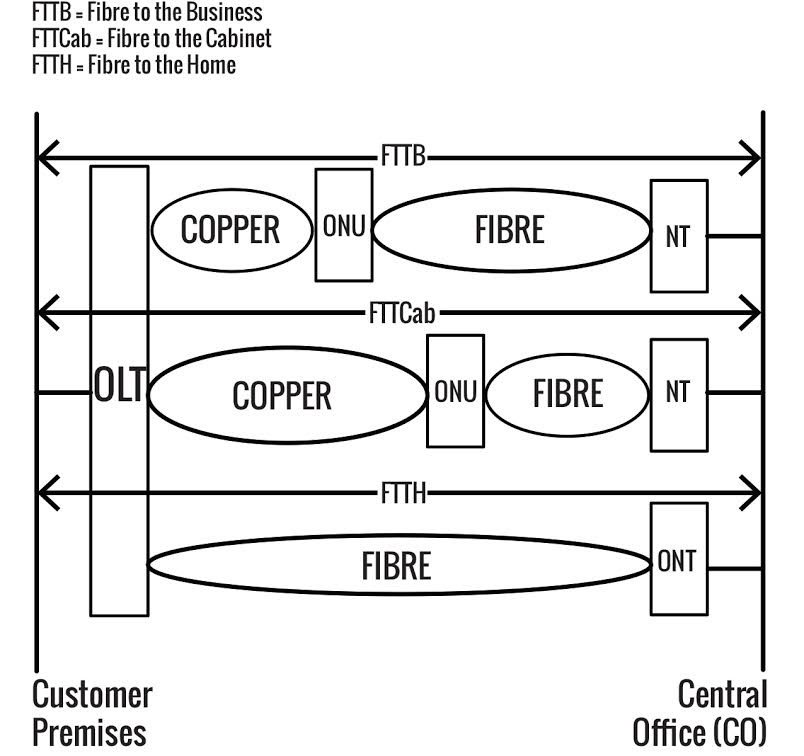GPON is a point-to-multipoint access network. Its main characteristic is the use of passive splitters in the fiber distribution network, enabling one single feeding fiber from the provider to serve multiple homes and small businesses.
GPON has a downstream capacity of 2.488 Gb/s and an upstream capacity of 1.244 Gbp/s that is shared among users. Encryption is used to keep each user’s data secured and private from other users. Although there are other technologies that could provide fiber to the home, passive optical networks (PONs) like GPON are generally considered the strongest candidate for widespread deployments.
GPON is specified to be a single or dual fiber system, but almost all GPON systems are single fiber like virtually all popular FTTH technologies. There is little reason to use dual fibers, although this option is indeed allowed in the standard.

Gigabyte Passive Optical Network, known as GPON, rely on fiber optic cables to deliver video, data and voice signals. GPON networks are currently the leading form of Passive Optical Networks (PONs), and offer up to a 1:64 ratio on a single optical fiber, meaning, a single fiber from the OLT can deliver video, data and voice signals to up to 64 end users (or residences).
Compared to the standard copper wire in most distribution networks, GPON networks are 95% more energy efficient – they use economical light signalization over fiber optic cable, as opposed to electrical signals over copper and coaxial cable. In addition to efficiency, Gigabyte Passive Optical Networks provide a low cost solution to adding new users by using optical splitters, which makes it easy to add and manage new customers, making GPON networks very desirable in populated areas.
GPON Components
Optical Line Terminal (OLT): The OLT is the ultimate network manager and controls all of the GPON network traffic, in the form video, data and voice signals, and sends them downstream to the ONTs on the other end. The OLT also receives these signals from the end user’s ONT, and sends them on their way to their destination over the Internet.
To ensure that the downstream and upstream signals do not interfere with each other, they are sent on different light wavelengths. Downstream traffic is sent at 1550nm (video), and 1490nm (data and voice), and upstream traffic is sent back at 1310nm.
Fiber Optic Splitter: Optical Splitters play an important role in GPON networks by allowing a single fiber optic cable to be shared, or split, among many end users. Optical Splitters are installed in each GPON network between the GPON OLT and the GPON ONTs that the OLT serves. Although it sounds simple, splitting level and ratio designs must be taken into consideration when designing a GPON network. For example, one optical splitter can provide video, data and voice services for up to 64 end users in a number of topographies including centralized, where one splitter distributes the signals to 64 end users; and cascade splitting, where one splitter distributes the signals to other splitters which then delivers the signals to up to 64 end users.
Optical Network Terminal (ONT): The ONT is an ‘optical modem’ that connects to the opposite end of the OLT – at the end user’s residence. It acts as the interface with the end user’s equipment – computers, televisions, WiFi, VoIP phones, etc. Data received from the end user is then aggregated, optimized and sent by the ONT to the upstream OLT. ONT’s also have the ability to broadcast WiFi throughout the end user’s home
The ONT is also known as Optical Network Unit (ONU). ONT is an ITU-T term, while ONU is an IEEE term. They both refer to the end user side equipment in a GPON network. A small difference between them might be the application locations. ONUs can work in different temperature and weather conditions.
How far GPON Reach?
The distance between the GPON OLT and the ONT is generally determined by the launch power of the optical transmitter, receive sensitivity of the far end receiver, and the optical loss associated with the optical distribution network (ODN). Optical loss comes primarily from connectors, splices, and splitter.
A GPON network can reach up to 20 km and provide service up to 64 end users. GPON utilizes both upstream and downstream data by means of Optical Wavelength Division Multiplexing (WDM).

Why GPON?
With technology constantly growing, and end users demanding faster internet speed, fiberoptic technology is the absolute way to go. Fiber to the Home (FTTH) networks continue to be in high demand because of this. Fiber cables are the only thing that can support the demand for higher speeds as well as distance within networks. Fiber optic cables have another advantage over metal cables, such as copper, in that they are less susceptible to interference. Spark hazards are always a possibility when using a metal cable to transmit signal. Small sparks can occur when sending electric potentials down a metal medium, these small sparks have the potential to cause shortages. By using GPON fiber optic cables, this will eliminate that hazard due to no current being transmitted. With a single optical fiber being able to support multiple users due to the use of passive optical splitters makes GPON an advantage by reducing equipment, satisfying high density areas as well as supporting triple play service; voice, date and IP video at the demanding rate of the public. With ethernet connections being only point to point, GPONs clear advantage is it being point to multipoint as well as offering higher downstream speeds then EPON/GEPON.





